

Fifty Quick Ideas to… by Gojko Adzic et al. This book will help you write better stories, spot and fix common issues, split stories so that they are smaller but still valuable, and deal with difficult stuff like crosscutting concerns, long-term effects and non-functional requirements.

Above all, this book will help you achieve the promise of agile and iterative delivery: to ensure that the right stuff gets delivered through productive discussions between delivery team members and business stakeholders. Twenty Ways to Split Stories - XP123. Splitting stories lets us separate the parts that are of high value from those of low value, so we can spend our time on the valuable parts of a feature.
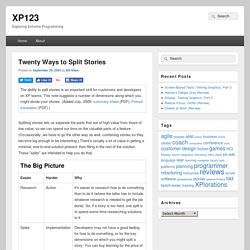
(Occasionally, we have to go the other way as well, combining stories so they become big enough to be interesting.) There's usually a lot of value in getting a minimal, end-to-end solution present, then filling in the rest of the solution. Gojko. Problems: Story is too big to split and estimate; business users don’t accept any breakdown proposed by the delivery team; team is inexperienced and thinks about technical splitting only;new project starts and no simple starting stories can be foundSolution: User Story Hamburger.

How You'll Probably Learn to Split Features. I originally wrote this article in 2006.

I have written a little more on this topic in Three Steps to a Useful Minimal Feature. These days I tend to use the terms story and feature interchangeably. I apologize for the confusion that this might create. Wherever necessary, substitute the term you prefer. 15 Ways to Split an Epic, a Team Exercise - blogs.collab.net. Your Scrum Team has been hired by a physical fitness expert to develop a mobile device application to prescribe daily personalized exercise routines and diets for a wide range of people.
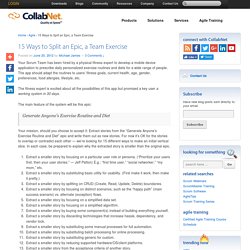
The app should adapt the routines to users’ fitness goals, current health, age, gender, preferences, food allergies, lifestyle, etc. The fitness expert is excited about all the possibilities of this app but promised a key user a working system in 30 days. The main feature of the system will be this epic: The Soul of Design: Harnessing the Power of Plot to Create Extraordinary Products. What makes the Apple iPhone cool?
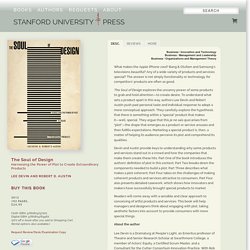
Bang & Olufsen and Samsung's televisions beautiful? Any of a wide variety of products and services special? The answer is not simply functionality or technology, for competitors' products are often as good. The Soul of Design explores the uncanny power of some products to grab and hold attention—to create desire. Dual-Track Scrum. Posted by marty cagan on September 17, 2012 Tags: scrum, agile, product discovery When I first start working with an Agile product team, one of the most common situations I find is where the teams have long and frustrating Sprint planning meetings because backlog items are poorly defined and not well understood; they have slow velocity as well as poor design because details are still being worked out during the Sprint; and the amount of waste and rework is very high because backlog items have not been validated.

Remember that our higher order objective is to validate our ideas the fastest, cheapest way possible. Actually building and launching a product idea is generally the slowest, most expensive way to validate the idea. Running Lean — Splitting User Stories - Agile For All. Working from a prioritized backlog of small user stories allows a team to get value and high-quality feedback on frequent intervals.
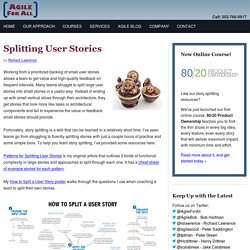
Many teams struggle to split large user stories into small stories in a useful way. Instead of ending up with small vertical slices through their architecture, they get stories that look more like tasks or architectural components and fail to experience the value or feedback small stories should provide. Fortunately, story splitting is a skill that can be learned in a relatively short time. Inspired: How to Create Products Customers Love by Marty Cagan. Impact Mapping. O'Reilly Media - Tech Books, DRM-Free Ebooks, Videos. The high points in this book from Jeff Patton are too numerous to mention.
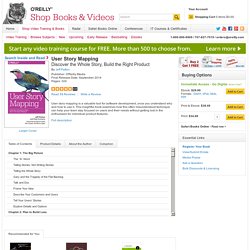
I found myself taking copious notes, and you could do the same, but it would probably make more sense to keep it near you and dip into it regularly until you have fully digested it. It is filled with good quotes e.g. 'There's always more to build than you have people, time, or money for. Always.' (Ch2 p21). Chapter 5 is a real gem - a real world example of how to map stories, and so down to earth that you carry it with you.
It is a book that makes clear the rationale behind user stories i.e. it doesn't simply contain a description of: 'As a.. 'Stories get their name from how they should be used, not what should be written.' There is a breadth of experience here: the author brings together old ideas, 'card, collaboration, confirmation' with newer ideas such as the Lean Startup 'build, measure, learn'. Lean Analytics Book. The Movement That Is Transforming How New Products Are Built And Launched. Start With Why - Simon Sinek TED talk. Specification by Example. Jeff Patton's Holistic Product Design & Development Blog. Agile Product Ownership in a Nutshell. David Bland.